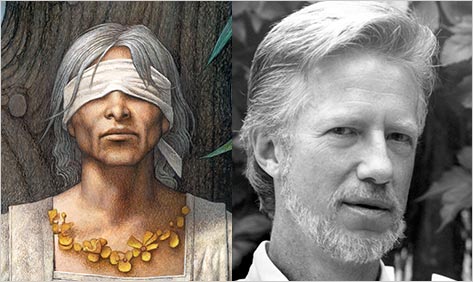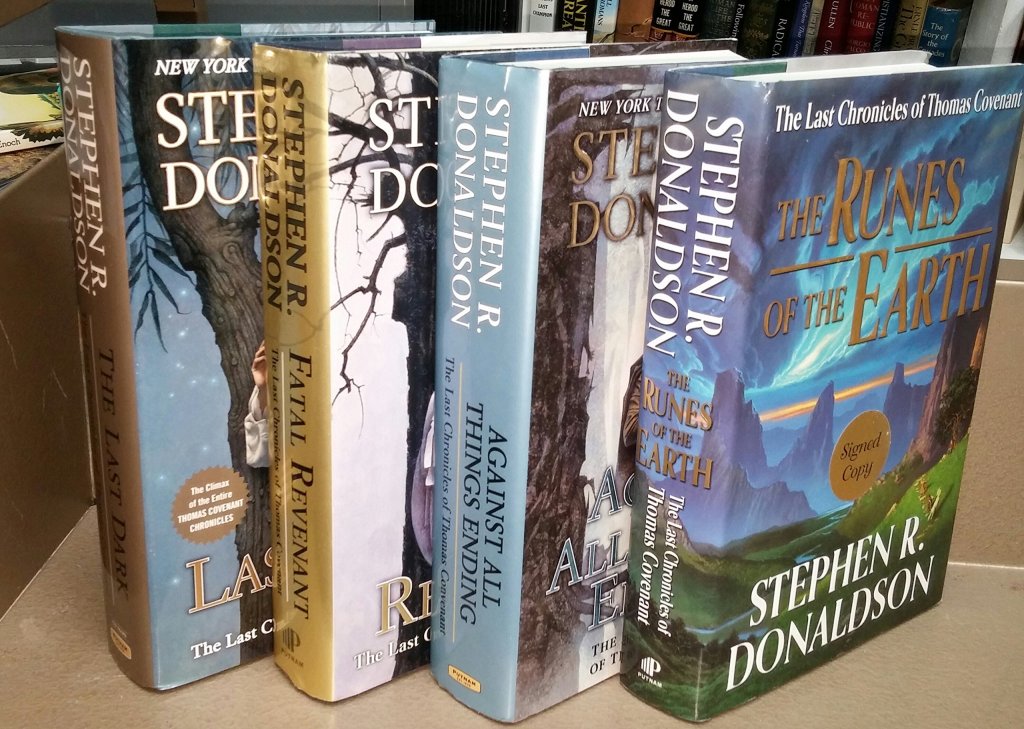Fantasy fiction was never really my thing when I was much younger than I am now. Yes, I read a fair amount of science fiction, and I still do. But while I liked the idea of fantasy, for some reason I could never sit down and read anything in the genre, not even Tolkien. We were given The Hobbit to read in school, but I couldn’t take to it. But a memory that sticks with me many decades later is finding a copy of The Power That Preserves in the house I grew up in. The cover of that book hit me, and the blurb at the back intrigued me, but not enough to read it. It was also book three of a trilogy, and I didn’t see the preceding two books lying around.

Fast forward ten years or so and I’m working in a local hotel and nightclub. A colleague and close friend at the time was, like me, a voracious reader. But while I was mainlining Robert Ludlum thrillers and other books from the genre, this guy was knees-deep in fantasy fiction. He reintroduced me to Stephen R. Donaldson and The Chronicles of Thomas Covenant. He did so in such a beguiling way, that I decided to stick my toes in the water.
First published in 1977, Lord Foul’s Bane was an instant success for important reasons. It introduced me to a different kind of hero, and ultimately a different type of Hero’s Quest. Covenant himself is a distinctly unlikeable character, but at the outset our sympathies are with him. He’s a successful writer who contracts leprosy, and finds himself an outcast in society, divorced from his wife Joan, and alienated from his young son Roger. He has plenty of reasons to be bitter and hateful. The only thing he holds onto, apart from his cynicism, is his white gold wedding ring. A chance meeting with a beggar on a rare trip into town results in Covenant being hit by a police car and rendered unconscious. When he comes to, he’s not where he should be. Covenant has found himself in The Land.

Donaldson’s epic series has been described as The Lord of the Rings for adults. This comparison is unfair on both works, but I see why it’s being made. Covenant isn’t in the Land long before he quickly gets his sense of touch back and his body starts to heal itself from its affliction. The euphoria maddens Covenant to the extent that among the first things he does is rape a young woman who tries to help him. Even now, many years later, this is an incident that haunts me. How can you root for a protagonist who commits such a heinous act? The truth is, you can’t, not really. And what Donaldson does well, in my opinion, is to allow this crime to follow Covenant throughout this book and beyond.
The Land is rich with Earthpower, a kind of energy that permeates within every living thing. The girl who helps Covenant, Lena, applies a muddy compound called hurtloam to his wounds, which heals his body if not his mind. His deformed right hand, as well as the presence of his white gold ring, confirms to Lena that Covenant is the reincarnation of Berek Halfhand, a Lord from eons past who saved the Land from the evil Lord Foul, who has been up to his tricks again despite banishment. Covenant, for his part, refuses to believe any of this is real, and thus nothing he says or does carries any consequence. Far from being the Land’s saviour, he styles himself on his unbelief, giving the trilogy its full name: The Chronicles of Thomas Covenant, The Unbeliever.
Donaldson readily uses many of not all of the available tropes employed in the genre of classic fantasy fiction. There is the Hero (Covenant), the Quest (destroy once and for all the threat of Lord Foul and his minions), a place of magic (The Land), the totems of power (the white gold ring, the One Tree, the Staff of Law), mythical creatures (Giants, Ranyhyn, Demondim, Elohim, Forestals, etc), and of course romance, which features heavily in later volumes with the introduction of Covenant’s doctor from our world, Linden Avery. But Donaldson subverts our expectations, and challenges us to put aside our preconceptions. As mentioned above, Covenant is not the hero the Land deserves, but it certainly needs him. As each of his companions (another trope that bears mentioning) regale him with stories of their ancestry and past victories and defeats, the object is to convince Covenant enough to help even when he doesn’t believe any of what he’s told. It’s a hard ask, but Donaldson does it in such a way, giving each of his characters distinctive voices and histories, that even if you feel Covenant may not be up to the job, you desperately want someone to step in and save the day and the Land.

Donaldson wrote two trilogies between 1977 and 1983, completing the second chronicles with White Gold Wielder. He completed a two book fantasy series, Mordant’s Need, and a five book science fiction epic, The Gap Cycle, which is an extraordinary piece of work. He also found the time to write some crime fiction under the Reed Stephens pseudonym, The Man Who… But in 2004, he published what was to be first of a quadrilogy, The Final Chronicles of Thomas Covenant: The Runes of the Earth. It took me a long time for get to this, but when I found that all four books where in my local library at the time, I borrowed them all and read them through at the end of last year and into the beginning of this one. It helped that before each book begins properly, there is a concise summary of everything that happened before. Maps and a brilliant glossary are also included, both massively helpful because the cast list and place names are plentiful and it’s a complex job following everything.
And this leads me to a very important point I feel I must make. Donaldson’s writing style for these novels in particular is not for everyone. The Land and its citizens are ornate and love their lore and the very nature of storytelling. Donaldson’s use of language is both immersive and off-putting. I found it necessary to put ample time away in order to approach these complex books. Some critics say they’re hard to read, and indeed some passages are long and detailed, so it’s best not to approach these tired or cranky. They are, however, complemented by some stunning actions scenes that take up entire chapters. It’s not just the fate of the characters or the Land that is at stake, it’s the nature of Time and the Universe, too. Lord Foul’s ultimate ambition is to undo Time and bring darkness throughout all existence. The last book of the Chronicles, The Last Dark, is a 550 page race against the clock, and is truly stunning in its resolution. Covenant’s atrocious crime from book one still has a price to exact, one that must be paid in full. The circle must be complete in order for justice to be served. It’s only right.

But it is not just about the story; it’s about the Land and all who live in it. Not only are the Giants the real heroes on show here, but the haruchai, a race of warriors that shun magic and weapons but take pride in prowess and stamina, offer the Unbeliever their hard-earned support, and without these and other races, Covenant and Avery would have a chance of defeating Lord Foul. All ten books in the series contain wild magic, victories, defeats, betrayal, death and rebirth; hope where there should be none; love where there really isn’t time; and healing, because that’s what we all need, no matter where we live.
Donaldson continues to write fantasy fiction. He’s two books into another epic saga, The Great God’s War. I’ve read the first one and enjoyed it, but it’s going to take something special to usurp Covenant and the Land from the top of my list.



Pingback: My Year in Books and Sudoku: 2020 | What I think About When I Think About Writing.
Pingback: Red Harvest Moon (The Wandering Knife Book 1) by Miles Hurt | What I think About When I Think About Writing.